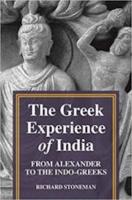
Princeton (2019) h/b 525pp £30.00 (ISBN 9780691154039)
This is a magisterial work with plenty to complement and enrich the writings of those like W.W. Tarn, A.K. Narain and Jean W. Sedlar, who have already tempted classicists to explore the world encountered by Alexander the Great, his entourage and their successors. S.’s aim is to display the ‘encounter of two incommensurable civilisations that came face to face for two pregnant centuries’ (p. 2) and what they may have learnt from each other. His footnotes and bibliography attest to an impressive array of reading from a wide range of perspectives.
The work is divided into 3 parts. In part I we are introduced to a plethora of writers, from ancient to modern times, who have been fascinated by the cultures of India and the eastern lands. These include a number of Greeks such as Onesicritus, Nearchus and especially Megasthenes. From the Roman period we have the life of Apollonius of Tyana which includes his travels to India. There is a good survey of the ancient sources, and the more problematic ones from India whose dating is less certain. This is followed by an account of Alexander in India, his possible motives for conquests and settlements, and his intellectual, scientific and philosophical entourage. A chapter looks at the deities Heracles and Dionysus, and the significance of their associations with India. S. then surveys the natural history of India and the mixture in the sources of the reliable and the utterly fantastical.
Part II focuses on Megasthenes’ Description of India (written c. 300 BC) and what kind of writer he was or aimed to be. His work exists only in fragments (short excerpts or longer paraphrases) quoted by others ‘and we know frustratingly little about him’ (p. 129). Megasthenes was a Greek but we do not know his place of origin. He travelled to India as an ambassador for King Seleucus to the court of Candragupta Maurya (the Greek Sandrocottus) in Patiliputra (present day Patna), so, as an eyewitness, he is potentially an authoritative and well-informed writer. He was the author of the most extensive description of India—its geography, peoples, customs and (to some extent) history written by a Greek.
S. presents his arguments for the date of Megasthenes’ activity, and in section 6 he endeavours to determine the structure of his book. He considers the writer from different perspectives, particularly the different attitudes towards barbarians that emerged in the context of Alexander’s campaigns and conquests. In section 8 we are presented with a number of Indian sources and what we can determine from them.
Part III ‘Interactions’ looks at the possible areas of cultural interaction, especially concerning philosophical notions. ‘Greeks were entranced by Indian philosophy from early times—Pythagoras … was said to have longed to go to India but never made it’ (p. 290)—and we have the account of Alexander meeting a group of naked ascetics in Taxila. There is a charming illustration of this scene from an ‘Alexander Romance’ MS in Venice. S. presents us with an array of material focused on gymnosophists, religious and philosophical teachers and their teachings, and especially ‘The Questions of King Milinda: Debate and Disputation’ (p. 365ff.), one of the most accessible works of ancient Buddhist philosophy. Milinda is Menander, an Indo-Greek king who ruled from 155-130 BC from a capital at Sagala (present-day Sialkot).
There is a considerable number of b/w illustrations of places, objets d’art, plans of sites and maps—(map 2.1 on Alexander’s India has rather congested detail since it encompasses a considerable area)—and all help to make some aspects of unfamiliar places and cultural artefacts more vivid. Misprints are few and trivial. The bibliography is extraordinarily wide-ranging and there is a good index. This volume is a most impressive achievement and there is much to quarry here.
Stephen Kern
